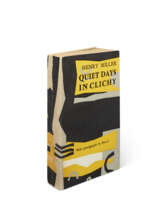ID 1108934
Lot 135 | Henry Miller (1891-1980)
Valeur estimée
£ 5 000 – 7 000
Autograph correspondence and typed drafts with manuscript corrections, [late 1920s - after 1979]
6 typed drafts of magazine articles with manuscript annotations, 20 items of correspondence – of which 16 are autograph and 3 typed with signatures – a copy of a London periodical containing an essay by Miller, and the CV of his friend, the artist Benjamin Benno. Together approx. 108 pages with a 32-page magazine, various sizes. Provenance: 1) David Edgar – Elizabeth R. Edgar; Sotheby's New York, 6 May 1981, lots 78, 81, 83, 84, and 85; 2) Sotheby's, 29 & 30 June 1982, lot 510.
An archive of Miller’s writings spanning his career and centering on his friendships with the artists David Edgar and Benjamin Benno. Miller sent copies of his unpublished essays and articles to friends for their feedback and for them to enjoy reading. The present collection contains: a typed fair copy of ‘Looking Down from the Empire State’, sent to Madeleine Boyd, his agent; a carbon copy of a typed draft of ‘Into the Future’ with a manuscript address ‘To David Edgar from Henry’; an early typed draft of ‘The Wisdom of the Heart’ with manuscript corrections; a carbon copy of a typed draft of ‘The Brooklyn Bridge’ with manuscripts corrections, sent to David Edgar (‘En souvenir de notre amitié terrestre, conjugal, austère, et cetera. Henry’); and drafts of ‘Benno the Wild Man of Borneo’ and ‘Chez Benno’, signed (‘by Henry Miller’) and sent to Benjamin Benno. Miller’s correspondence comprises 20 letters, postcards and memoranda, the majority autograph, of which eight are to David Edgar and 12 to Benjamin Benno, written in Paris, New York and Big Sur, California. The last two items are a copy of the periodical London Bulletin, June 1938, no. 3 (London: The London Gallery Ltd.), in which ‘Chez Benno’ was published, and a copy of Benjamin Benno’s CV with the artist’s date of death added in manuscript, apparently by Miller.
The author Henry Miller began his career in Paris where he met other bohemian expatriates, notably here the artists David Edgar and Benjamin Greenstein Benno. He left New York in 1930 with 10 dollars lent to him by a friend. In Paris, he and his circle continued to live hand to mouth: one memorandum to Benno in this collection accompanied a loan of 10 francs (‘all I could muster up at the moment’). In another note he asks Benno for a loan in return (‘I’m dead broke and rustling for a meal to-night’). He remained in Paris until the outbreak of war, his career having reached a milestone with the publication of his novel Tropic of Capricorn in 1939. After returning to New York he continued to correspond with his friends in Paris, in one instance here asking Benno to give his love ‘to the Harveys and to Marcel Duchamp if you see him’. He socialised within Greenwich Village's artistic circles, writing in one note about a plan to send a copy of a book to the café owner Romany Marie ('that old wag ... That’s almost as good as broadcasting it over the radio'). Miller moved to Big Sur, California, in 1944/5, where much of the correspondence in this collection originated. Notably, one autograph letter to David Edgar (12 September 1954) contains messages from Miller and from his friend and biographer Alfred Perlès, who was lived with him in California while he wrote his biography. Benjamin Benno died in New York in 1979, as an annotated copy of his CV in this collection attests; Miller died the following year.
| Artiste: | Henry Valentine Miller (1891 - 1980) |
|---|---|
| Lieu d'origine: | France, Etats-Unis |
| Artiste: | Henry Valentine Miller (1891 - 1980) |
|---|---|
| Lieu d'origine: | France, Etats-Unis |
| Adresse de l'enchère |
CHRISTIE'S 8 King Street, St. James's SW1Y 6QT London Royaume-Uni | |||||
|---|---|---|---|---|---|---|
| Aperçu |
| |||||
| Téléphone | +44 (0)20 7839 9060 | |||||
| Commission | see on Website | |||||
| Conditions d'utilisation | Conditions d'utilisation |












